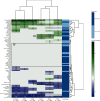Characterizing Important Dietary Exposure Sources of Perfluoroalkyl Acids in Inuit Youth and Adults in Nunavik Using a Feature Selection Tool
- PMID: 38683744
- PMCID: PMC11057678
- DOI: 10.1289/EHP13556
Characterizing Important Dietary Exposure Sources of Perfluoroalkyl Acids in Inuit Youth and Adults in Nunavik Using a Feature Selection Tool
Abstract
Background: Previous studies have identified the consumption of country foods (hunted/harvested foods from the land) as the primary exposure source of perfluoroalkyl acids (PFAA) in Arctic communities. However, identifying the specific foods associated with PFAA exposures is complicated due to correlation between country foods that are commonly consumed together.
Methods: We used venous blood sample data and food frequency questionnaire data from the Qanuilirpitaa? ("How are we now?") 2017 (Q2017) survey of Inuit individuals y of age residing in Nunavik (). Adaptive elastic net, a machine learning technique, identified the most important food items for predicting PFAA biomarker levels while accounting for the correlation among the food items. We used generalized linear regression models to quantify the association between the most predictive food items and six plasma PFAA biomarker levels. The estimates were converted to percent changes in a specific PFAA biomarker level per standard deviation increase in the consumption of a food item. Models were also stratified by food type (market or country foods).
Results: Perfluorooctanesulfonic acid (PFOS), perfluorodecanoic acid (PFDA), and perfluoroundecanoic acid (PFUnDA) were associated with frequent consumption of beluga misirak (rendered fat) [14.6%; 95% confidence interval (CI): 10.3%, 18.9%; 14.6% (95% CI: 10.1%, 19.0%)], seal liver [9.3% (95% CI: 5.0%, 13.7%); 8.1% (95% CI: 3.5%, 12.6%)], and suuvalik (fish roe mixed with berries and fat) [6.0% (95% CI: 1.3%, 10.7%); 7.5% (95% CI: 2.7%, 12.3%)]. Beluga misirak was also associated with higher concentrations of perfluorohexanesulphonic acid (PFHxS) and perfluorononanoic acid (PFNA), albeit with lower percentage changes. PFHxS, perfluorooctanoic acid (PFOA), and PFNA followed some similar patterns, with higher levels associated with frequent consumption of ptarmigan [6.1% (95% CI: 3.2%, 9.0%); 5.1% (95% CI: 1.1%, 9.1%); 5.4% (95% CI: 1.8%, 9.0%)]. Among market foods, frequent consumption of processed meat and popcorn was consistently associated with lower PFAA exposure.
Conclusions: Our study identifies specific food items contributing to environmental contaminant exposure in Indigenous or small communities relying on local subsistence foods using adaptive elastic net to prioritize responses from a complex food frequency questionnaire. In Nunavik, higher PFAA biomarker levels were primarily related to increased consumption of country foods, particularly beluga misirak, seal liver, suuvalik, and ptarmigan. Our results support policies regulating PFAA production and use to limit the contamination of Arctic species through long-range transport. https://doi.org/10.1289/EHP13556.
Figures





Similar articles
-
Sex specificity in associations between exposure to a mixture of per and poly-fluoroalkyl substances and anxiety among US adults.J Expo Sci Environ Epidemiol. 2025 Jul;35(4):578-589. doi: 10.1038/s41370-024-00741-3. Epub 2025 Jan 7. J Expo Sci Environ Epidemiol. 2025. PMID: 39775104
-
Association of diet with per- and polyfluoroalkyl substances in plasma and human milk in the New Hampshire Birth Cohort Study.Sci Total Environ. 2024 Jul 10;933:173157. doi: 10.1016/j.scitotenv.2024.173157. Epub 2024 May 11. Sci Total Environ. 2024. PMID: 38740209 Free PMC article.
-
Levels and determinants of exposure to perfluoroalkyl substances in French pregnant women from the SEPAGES cohort.Environ Int. 2025 Jul;201:109559. doi: 10.1016/j.envint.2025.109559. Epub 2025 May 27. Environ Int. 2025. PMID: 40480099
-
Portion, package or tableware size for changing selection and consumption of food, alcohol and tobacco.Cochrane Database Syst Rev. 2015 Sep 14;(9):CD011045. doi: 10.1002/14651858.CD011045.pub2. Cochrane Database Syst Rev. 2015. PMID: 26368271 Free PMC article.
-
Effectiveness and safety of vitamin D in relation to bone health.Evid Rep Technol Assess (Full Rep). 2007 Aug;(158):1-235. Evid Rep Technol Assess (Full Rep). 2007. PMID: 18088161 Free PMC article.
References
-
- AMAP (Arctic Monitoring and Assessment Programme). 2021. POPs and Chemicals of Emerging Arctic Concern: Influence of Climate Change, Summary for Policy-Makers. Tromsø, Norway: AMAP.
-
- Caron-Beaudoin É, Ayotte P, Blanchette C, Muckle G, Avard E, Ricard S, et al. . 2020. Perfluoroalkyl acids in pregnant women from Nunavik (Quebec, Canada): trends in exposure and associations with country foods consumption. Environ Int 145:106169, PMID: 33041046, 10.1016/j.envint.2020.106169. - DOI - PubMed
Publication types
MeSH terms
Substances
LinkOut - more resources
Full Text Sources

